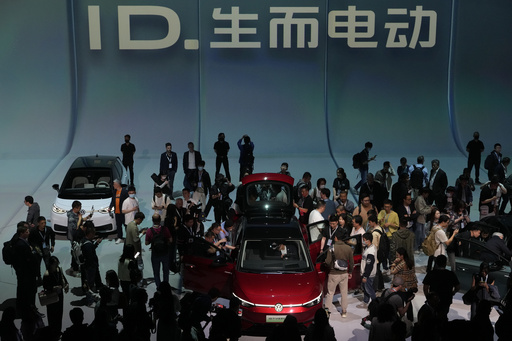
FRANKFURT, Germany — The European Union has officially implemented increased customs tariffs on electric vehicles (EVs) imported from China, marking a significant moment in an ongoing trade dispute. This move highlights concerns surrounding Chinese government subsidies and the rising exports of green technologies into the EU’s market of 27 nations.
Initially put in place provisionally in July, these tariffs were finalized after unsuccessful negotiations between the EU and China. While discussions are set to continue, there is a possibility that the EU may revoke the tariffs if both sides can reach a mutually beneficial agreement.
The European Commission, the executive branch of the EU, conducted a comprehensive investigation spanning eight months. This inquiry revealed that Chinese manufacturers of electric vehicles are benefiting from substantial government support, allowing them to undercut European competitors on pricing, capture significant market share, and potentially threaten jobs within Europe. The newly enacted tariffs vary based on the manufacturer: BYD is assessed a 17% duty, Geely faces an 18.8% duty, and state-owned SAIC bears a 35.3% tariff. Notably, other Chinese manufacturers, including Volkswagen and BMW, will incur a 20.7% duty, with Tesla receiving a lesser rate of 7.8% determined on an individual basis.
European Commission Executive Vice-President Valdis Dombrovskis emphasized the Union’s commitment to maintaining fair market practices and protecting the European industrial framework with these “proportionate and targeted measures.” These tariffs are set to remain effective for a duration of five years unless a favorable resolution is reached between the involved parties.
The urgency behind the European Commission’s action is rooted in the drastic increase in the market presence of Chinese electric cars, which expanded from just 3.9% in 2020 to a notable 25% by September 2023. It has been argued that this surge was made possible through the extensive subsidies provided across various production stages, such as cheap land offered by local authorities, below-market prices for essential materials like lithium and batteries from state-owned enterprises, along with tax breaks and low-interest loans facilitated by state-controlled banks.
The rapid escalation in market share has incited worries that the influx of Chinese vehicles could undermine the EU’s capability to produce its own innovative green technologies necessary for addressing climate change. Moreover, this trend poses a risk to the jobs of 2.5 million workers in the automotive sector and 10.3 million additional jobs that are indirectly linked to electric vehicle manufacturing. European governments are particularly cautious, bearing in mind the damaging impact of Chinese solar panel subsidies that drove local producers out of business, an outcome they are reluctant to repeat with their automotive industry.
Notably, this decisive action from the European Commission comes without a formal complaint from within the European automotive sector itself. Leaders in this industry, especially from Germany—home to prominent companies such as BMW, Volkswagen, and Mercedes-Benz—have expressed opposition to the tariffs. Their concerns pivot on potential retaliatory measures from China that could negatively impact European manufacturers, particularly since many affected vehicles are produced by domestic companies.
In response, Beijing has strongly criticized the EU’s investigation and the resulting tariffs, labeling them as protectionist and unjust. The Chinese Commerce Ministry has retaliated by initiating anti-dumping investigations into various European exports, including brandy, pork, and dairy products. Recently, provisional tariffs ranging from 30.6% to 39% have been imposed specifically on French and other European brandies, just after EU member states agreed to the EV tariffs.
Discussions between the EU and China have recently revolved around the idea of “price commitments,” where car manufacturers might agree to establish minimum sale prices for their EVs within Europe. Some Chinese automakers are considering setting up manufacturing facilities in Europe to circumvent tariffs and stay close to their target market. For instance, BYD is in the process of developing a plant in Hungary, while Chery has established a partnership to assemble cars in Catalonia, Spain.
Comparatively, the tariffs set by the Biden administration in the U.S. are set to jump to 100% from the current 25%. This steep increase would effectively eliminate almost all imports of Chinese electric vehicles into the U.S. In contrast, the EU’s goal is not to completely block imports but rather to procure affordable electric vehicles while addressing the issue of subsidies deemed unfair. The planned tariffs aim to create a more level playing field by approximating the potential distortion caused by the subsidies enjoyed by Chinese manufacturers.
While European countries also provide subsidies for electric vehicle purchases, this trade dispute raises critical questions about the fairness of these subsidies and their accessibility to all manufacturers versus creating an uneven market landscape favoring one side.
The implications for European consumers and automakers remain uncertain. The influence of these duties on vehicle pricing is still ambiguous, as Chinese manufacturers might opt to absorb the costs associated with the tariffs rather than passing those costs onto consumers. Currently, Chinese firms typically sell their vehicles at significantly higher prices in overseas markets compared to their domestic pricing in China, indicating a preference for profit margins over expanding market share, despite their recent success.
According to estimates from the Rhodium Group, five of BYD’s six models could maintain profitability in Europe even with a 30% tariff. For example, the BYD Seal U Comfort model is priced at 21,769 euros ($23,370) in China, whereas in Europe, it retails for around 41,990 euros ($45,078). The entry-level model of BYD’s compact Seagull, slated for European debut next year, is expected to be priced around $10,000 in China.
Although consumers may enjoy lower-priced options from Chinese automakers in the short run, the European Commission argues that allowing these subsidies to continue could eventually inhibit competition and lead to increased prices over time. As this trade saga unfolds, both the EU and China will need to navigate a complex landscape to achieve a satisfactory resolution.
